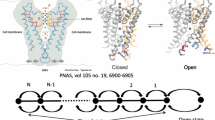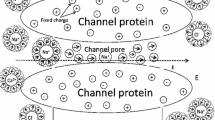Abstract
It is known from experimental studies that the Hurst exponent, which characterizes the degree of correlation of events in the sequence of channel lifetimes in the open and closed states, depends on the electrical transmembrane potential. However, the mechanism of this phenomenon remains unclear. In this study, we have constructed a model that enabled us to describe this phenomenon. Using the model, the dependencies of the Hurst exponent on the electrical transmembrane potential were calculated. It has been shown that the best agreement between theoretical and experimental data was observed when the dependence of the hydrophobic factor on the electrical transmembrane potential has been taken into account.






Similar content being viewed by others
REFERENCES
Varanda W.A., Liebovitch L.S., Figueiroa J.N., Nogueira R.A. 2000. Hurst analysis applied the study of single calcium-activated potassium channel kinetics. J. Theor. Biol. 206, 343–353.
Nogueira R.A., Varanda W.A., Liebovitch L.S. 1995. Hurst analysis in the study of ion current kinetics. Brasilian J. Med. Biol. 28, 491–496.
Kochetkov K.V., Kazachenko V.N., Aslanidi O.V., Chemeris N.K. Gapeev A.B. 1999. Non-Markovian gating of -activated -channels kidney cells Vero. Rescaled range analysis. J. Biol. Phys. 25, 211–222.
Kochetkov K.V., Kazachenko V.N., Aslanidi O.V. 2001. Time correlation in ion channel gating. Rescaled range analysis. Biol. membrany (Rus.). 18, 51–66.
Kazachenko V.N., Kochetkov K.V., Astashev M.E., Grinevich A.A. 2004. Fractal properties of the gating of potential-dependent channels in neurons of L. stagnalis. Biofizika (Rus.). 49, 852–865.
Kazachenko V. N., Kochetkov K.V., Aslanidi O.V., Grinevich A.A. 2001. Study of fractal properties of single ionic channel gating mechanism by the fast Fourier transform. Biofizika (Rus.). 46, 1062–1070.
Kochetkov, K.V., Kazachenko, V.N., Aslanidi, O.V. 2003. Employment of the wavelet transformation for analysis of single ion channel activity. Biol. membrany (Rus.). 20, 359–368.
Grinevich A.A., Astashev M.E. 2010. Fraktal’nye svoistva ionnykh kanalov (Fractal properties of ion channels). Saarbrucken: LAP Lambert Acad. Publ.
Liebovitch L.S., Fischbarg J., Koniarek J. 1987. Ion channel kinetics: A model based on fractal scaling rather than multistate Markov process. Math. Biosci. 84, 37–68.
Liebovitch L.S., Lullivan J.M. 1987. Fractal analysis of a voltage-dependent potassium channel from cultured mouse hippocampal neurons. Biophys. J. 52, 979–988.
Varanda W.A., Liebovitch L.S., Figueiroa J.N., Nogueira R.A. 2000. Hurst analysis applied the study of single calcium-activated potassium channel kinetics. J. Theor. Biol. 206, 343–353.
Moezzi B., Iannella N., McDonnell M.D. 2016. Ion channel noise can explain firing correlation in auditory nerves. J. Comput. Neurosci. 41, 193–206.
Moezzi B., Iannella N., McDonnell M.D. 2014. Modeling the influence of short term depression in vesicle release and stochastic calcium channel gating on auditory nerve spontaneous firing statistics. Front. Comput. Neurosci. 8, 163.
Colquhoun D., Hawkes A.G. 1977. Relaxation and fluctuations of membrane currents that flow through drug-operated channels. Proc. R. Soc. London Ser. B. 199, 231–262.
Croxton T.L. 1988. A model of the gating of ion channels. Biochim. Biophys Acta. 946, 19–24.
Horn R. 1987. Statistical methods for model discrimination. Applications to gating kinetics and permeation of the acetylholine receptor channel. Biophys. J. 51, 255–263.
McManus O.B., Magleby K.L. 1994. Accounting for the Ca2+-dependent kinetics of single large-conductance Ca2+-activated K+-channels in rat skeletal muscle. J. Physiol. (London). 443, 739–777.
Kazachenko V. N., Kochetkov K.V., 2003. Maxi Ca2+-activated K+ channels: Structure and gating. Biol. membrany (Rus.). 20, 99–120.
Liebovitch L.S. 1989. Analysis of fractal ion channel gating kinetics: Kinetics rates energy levels and activation energies. Math. Biosci. 93, 97–115.
Liebovitch L.S., Toth T.I. 1990. Fractal activity in cell membrane ion channels. Math. Approach. Cardiac. Arrythmias. 591, 375–391.
Millhauser G.L., Salpeter E.E., Oswald R.E. 1988. Diffusion models of ion channel gating and the origin of power-law distributions from single channel recording. Proc. Natl. Acad. Sci. USA. 85, 1503–1507.
Oswald R.E., Millhause G.L., Carter A.A. 1991. Diffusion model in ion channel gating. Extension to agonist-activated ion channels. Biopys. J. 59, 1136–1142.
Liebovitch L.S., Yang W. 1997. Transition from persistent to antipersistent correlation in biological systems. Phys. Rev. E. 56, 4557–4566.
Kurzynski M., Palacz K., Chelminiak P. 1998. Time course of reactions controlled and gated by intramolecular dynamics of proteins: Predictions of the model of random walk on fractal lattices. Proc. Natl. Acad. Sci. USA. 95, 11685–11690.
Liebovitch L.S., Toth T.I. 1991. A model of ionic channel kinetics using deterministic chaotic rather than stochastic processes. J. Theor. Biol. 148, 243–267.
Liebovitch L.S., Czegledy F. 1992. A model of ion channel kinetics based on deterministic motion in a potential with two local minima. Ann. Biomed. Engr. 84, 37–68.
Cavalcanti S., Fontanazzi F. 1999. Deterministic model of ion channel flipping with fractal scaling of kinetics rates. Ann. Biomed. Engr. 27, 682–695.
Liebovitch L.S., Krekora P. 2002. The physical basis of ion channel kinetics: The impotance of dynamics. Proc. Inst. Math. Appl. Univ. Minnessota. 129, 27–52.
Jensen M.O., Borhani D.W., Lindorff-Larsen K., Maragakis P., Jogini V., Eastwood M.P., Dror R.O., Shaw D.E. 2010. Principles of conduction and hydrophobic gating in K+ channels. Proc. Natl. Acad. Sci. USA. 107 (13), 5833–5838.
Jensen M.O., Jogini V., Borhani D.W., Leffler A.E., Dror R.O., Shaw D.E. 2012. Mechanism of voltage gating in potassium channels. Science. 336 (6078), 229–233.
Sigg D. 2014. Modeling ion channels: Past, present, and future. J. Gen. Physiol. 144 (1), 7–26.
Grinevich A.A., Astashev M.E., Kazachenko V.N. 2007. Model of multifractal gating of single ionic channels in biological membranes. Biochem. (Moscow) Suppl. Ser. A. 1, 253–269.
Gazzarrini S., Severino M., Lombardi M., Morandi M., DiFrancesco D., Etten J.L.V., Thiel G., Moroni A. 2003. The viral potassium channel Kcv: structural and functional features. FEBS Letters. 552 (1), 12–16.
Doyle D.A., Morais Cabral J., Pfuetzner R.A., Kuo A., Gulbis J.M., Cohen S.L., Chait B.T., MacKinnon R. 1998. The structure of the potassium channel: Molecular basis of K+ conduction and selectivity. Science. 280 (5360), 69–77.
Peng C.-K., Buldyrev S.V., Halvin S., Simons M., Stanley H.E., Goldberger A.L. 1994. Mosaic organization of DNA nucleotides. Phys. Rev. 49, 1685–1689.
Author information
Authors and Affiliations
Corresponding author
Additional information
Translated by E. Puchkov
Rights and permissions
About this article
Cite this article
Grinevich, A.A., Astashev, M.E. Modeling of the Mechanism of the Electrical Transmembrane Potential Influence on the Hurst Exponents in the Sequence of Lifetimes of a Single Ion Channel. Biochem. Moscow Suppl. Ser. A 13, 138–146 (2019). https://doi.org/10.1134/S1990747818060053
Received:
Revised:
Accepted:
Published:
Issue Date:
DOI: https://doi.org/10.1134/S1990747818060053




